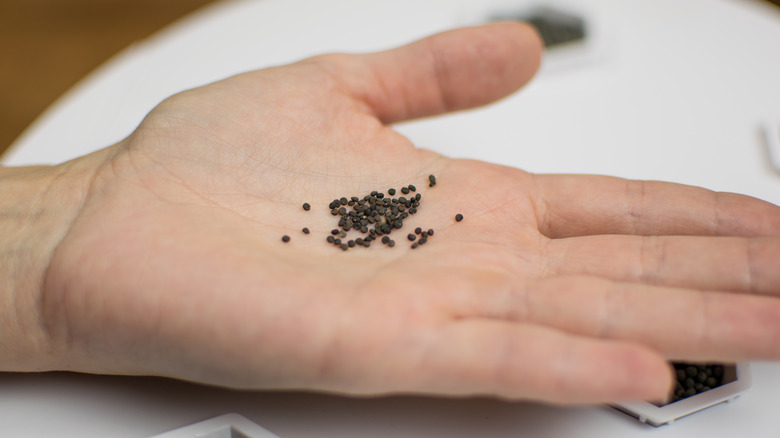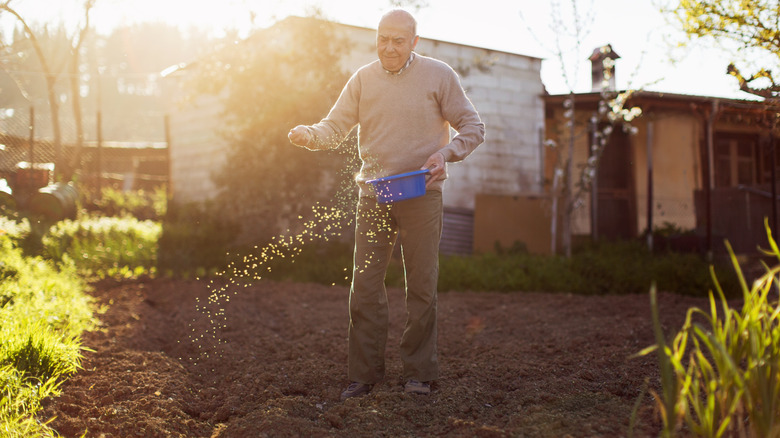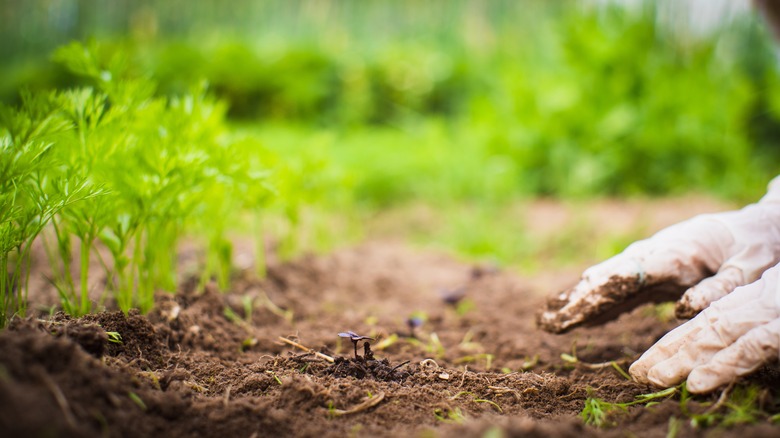Why You Should Mix Small Seeds With Sand Before Sowing
The eagerly awaited feathery beginnings of carrots are finally emerging from your carefully tended soil. But wait! Why are they all growing in one clump while the rest of their allotted area is bare and sad? Along with a number of other flowers, herbs, and vegetables, carrot seeds are little flecks of nearly nothing that can be hard to distribute evenly when you sow them. Make them infinitely easier to handle by combining them with sand. Fill up a salt shaker with the perfect ingredients and you'll never struggle with a delicate palmful of seeds again.
Uneven garden surfaces, wind and water, or just an unsteady hand are all reasons your tiny-seeded plants come up in concentrated clusters rather than tidy rows. Just like their seeds, the eventual sprouts are extremely small and difficult to thin. Plus, everything you have to remove amounts to wasted seed — and extra work. While this tip is not a guarantee that your seeds won't end up in unwanted places, it provides some control over one common problem. Whether you're direct sowing seeds in your garden or getting a jumpstart indoors, this tip is equally useful.
When and why to use a sand-seed mixture
The notoriously tiny carrot seed isn't the only plant that benefits from some help spreading out. Stirring up some sand and seeds is a boon for planting herbs like dill and oregano, flowers like poppies and foxglove, and other vegetables like lettuce and onions.
Spacing your small seeds is essential, just like when you press larger seeds into holes at the required depth and space from one another. It's just a lot harder if you're planting individual seeds barely larger than a grain of sand by hand. By letting this playground staple bulk up what you're planting, you're also spreading a filler material. For every five or so grains of sand you "plant," you'll have one seed, and that adds up to worry-free spacing.
Another particular issue with minuscule seeds is that they benefit from "surface sowing." This means that when you plant them, you won't cover them with much soil. This is much more easily accomplished with the help of sand and a salt shaker. Pressing them or very lightly raking them into the soil is all you'll need to do. The reason behind this is that the smaller the seed's size, the less energy it has to put toward sprouting.
How to make and use your mix
Get your pre-plants ready with some new sand and a salt shaker. Don't use sand you've collected from the outdoors, since it may already be contaminated with weed seeds. If you don't have any clean sand on hand, you can substitute it for cornmeal, an old-school gardening hack for sowing seeds.
The ratios of sand to seed don't need to be terribly precise. BBB seed recommends a blend of four to five parts sand to one part seed. If you don't feel like measuring, a pinch of seeds with a tablespoon of sand will do. You don't have to distribute the mixture with a salt shaker, but it's a clever way for savvy DIYers to reuse them. The extra benefit of the salt shaker is that the sprinkling action separates the seeds even more for better spacing.
You can use your seed/sand mix in a few different ways. If you're starting seeds indoors on trays, shake the contents evenly onto each section of the tray. For starting rows of plants, make a shallow indentation the length you'd like your row. Shake the ingredients over the row, cover it with a small amount of soil, tamp lightly, and water.


